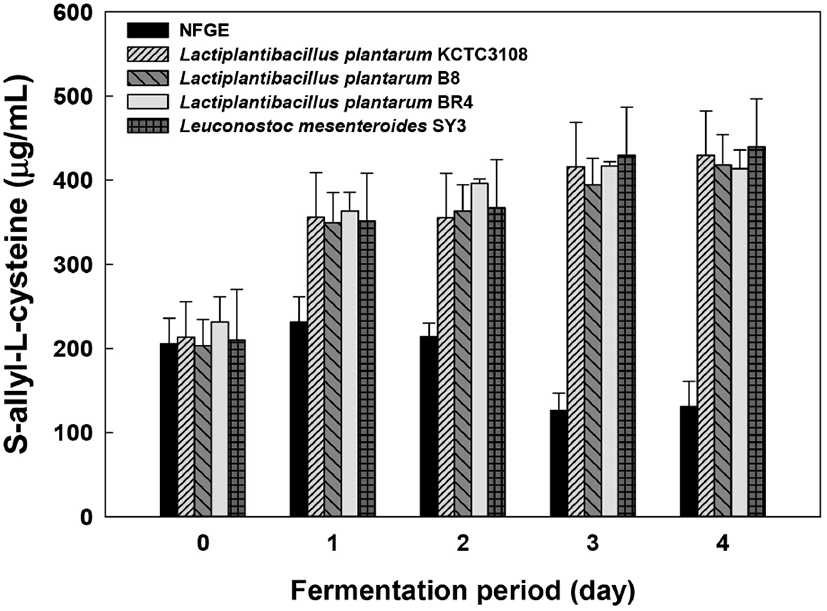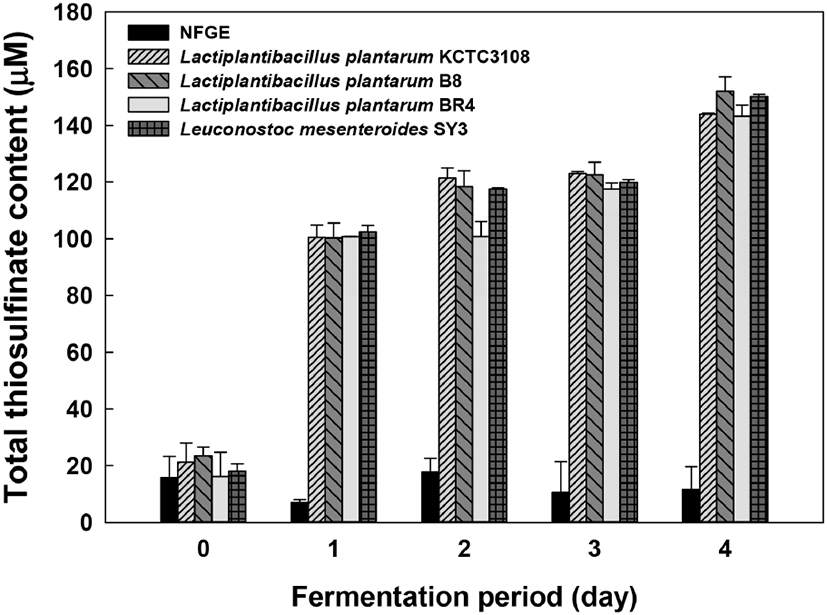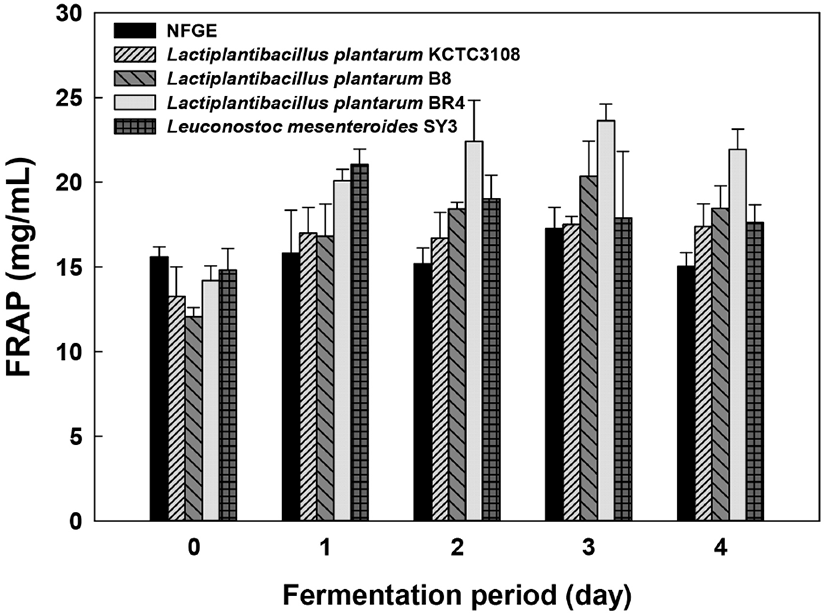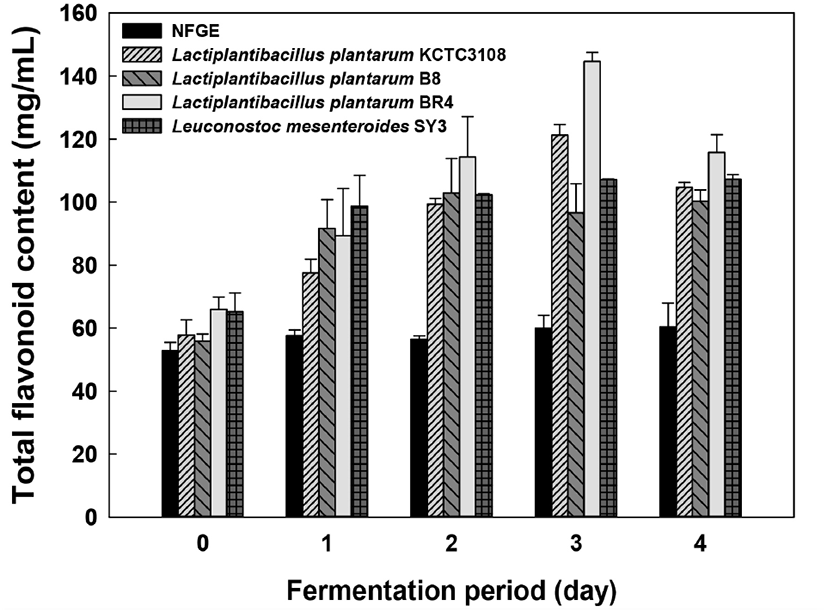Article
다양한 유산균으로 제조한 발효마늘의 품질 특성
송도영
1
, 황도영
1
, 박경희
1
, 박점련
2
, 강성국
1
, 함경식
1,*
Quality characteristics of fermented garlic by various lactic acid bacteria
Doyoung Song
1
, Do-Young Hwang
1
, Kyung-Hee Park
1
, Jeom-Leon Park
2
, Seong-Gook Kang
1
, Kyung-Sik Ham
1,*
1Department of Food Engineering and Solar Salt Research Center, Mokpo National University, Muan 58554, Korea
2Seongrim Agricultural Association Corporation, Muan 58557, Korea
*Corresponding author Kyung-Sik Ham, Tel: +82-10-9432-2425, E-mail:
ksham@mokpo.ac.kr
Citation: Song DY, Hwang DY, Park KH, Park JL, Kang SG, Ham KS. Quality characteristics of fermented garlic by various lactic acid bacteria. Korean J Food Preserv, 29(2), 254-262 (2022)
Copyright © The Korean Society of Food Preservation. This is an Open Access article distributed under the terms of the
Creative Commons Attribution Non-Commercial License (http://creativecommons.org/licenses/by-nc/4.0) which permits
unrestricted non-commercial use, distribution, and reproduction in any
medium, provided the original work is properly cited.
Received: Dec 03, 2021; Revised: Jan 04, 2022; Accepted: Jan 04, 2022
Published Online: Apr 30, 2022
4. 요약
본 연구에서는 발효식품으로부터 유래한 유산균 8종을 이용하여 제조된 발효마늘의 이화학적 특성, 항산화 활성 및 황화합물 함량을 비교 조사하였다. pH, 총산도 및 생균수를 측정하여 발효능이 뛰어난 4종의 유산균 L. plantarum KCTC3108, L. plantarum B8, L. plantarum BR4, Leu. mesenteroides SY3을 선별하고 기능성 평가를 하였다. SAC 및 총thiosulfinate 함량은 발효가 진행됨에 따라 증가하는 경향을 보였으며, 발효 초기에 비해 SAC는 각각 2.34, 2.30, 1.96, 2.62배 증가하였고, 총thiosulfinate는 각각 5.55, 6.06, 14.41, 7.56배 증가하였다. 철 환원력은 발효 4일 차에서 L. plantarum KCTC3108(17.39 mg/mL), L. plantarum B8(18.46 mg/mL), L. plantarum BR4 (21.94 mg/mL), Leu. mesenteroides SY3(17.62 mg/mL)로 조사되었으며 L. plantarum BR4 첨가구가 유의적으로 높게 나타났다(p⟨0.05). 총플라보노이드 함량은 발효 3일 차까지 증가하는 경향을 보였으며, 발효 전에 비해 각각 2.50, 1.79, 2.14, 1.54배 증가하였다. 이상의 결과로부터 L. plantarum BR4 균주를 이용하여 발효마늘 제조 시 황화합물 함량, 항산화 활성, 총플라보노이드 함량을 증가시키는 데 효과적인 것으로 나타났다. 이는 생리활성기능 증가를 통해 발효마늘을 활용한 기능성 식품가공 측면에서 활용이 기대된다.
Abstract
This study aimed to investigate quality characteristics and antioxidant activity of garlic fermented by lactic acid bacteria (LAB). Four LAB strains (Lactobacillus plantarum KCTC3108, Lactobacillus plantarum B8, Lactobacillus plantarum BR4 and Leuconostoc mesenteroides SY3) were selected for analysis based on their fermentation ability (pH and total acidity) from eight LAB strains isolated from fermented foods. Quality characteristics and antioxidant activity were measured during four days of fermentation. S-allyl-L-cysteine, total thiosulfinate content, total flavonoid content and ferric reducing antioxidant power of fermented garlic extract increased as fermentation progressed. After fermentation, the S-allyl-L-cysteine contents of garlic samples fermented with L. plantarum KCTC3108, L. plantarum B8, L. plantarum BR4 and Leuconostoc mesenteroides SY3 increased 2.34, 2.30, 1.96 and 2.62 times, respectively, and the total thiosulfinate contents increased 5.55, 6.06, 14.41, and 7.56 times, respectively, compared to those at the beginning of fermentation. Ferric reducing antioxidant power and total flavonoid content were 23.64 mg/mL and 144.65 μg/mL, respectively in garlic samples fermented with L. plantarum BR4 which were the highest values among the groups. Based on these results, L. plantarum BR4 was selected for garlic fermentation to develop a functional food.
Keywords: garlic; lactic acid bacteira; fermentation; S-allyl-L-cysteine; Lactobacillus plantarum; BR4
1. 서론
마늘은 백합과(Liliaceae) 파속(Allium)에 속하는 다년생 식물로, 특유의 자극적 냄새와 매운맛이 있어 향신료로 오랫동안 널리 사용되어 왔다(Mikaili 등, 2013). 마늘의 생리활성 기능으로 항암(Song과 Milner, 2001), 항노화(Rahman, 2003), 항고혈압(Demerdash 등, 2005), 항산화(Kaur과 Kapoor, 2002) 및 항염증(Lee 등, 2012) 등 다양한 연구결과가 보고된 바 있다. 또한, 특유의 자극적 냄새 및 매운맛 성분인 allicin, dially trisulfide(DATS), dallyl disulfide(DADS), diallyl sulfide (DAS), S-allyl-L-cysteine(SAC) 등과 같은 황화합물을 다량 함유하고 있는 것으로 알려져 있다(Hong 등, 2000). 이러한 황화합물은 체내에 들어가 효소 작용에 의해 황화수소로 바뀌어, 여러 가지 건강 기능을 나타내는 주요 원인 물질임이 최근 밝혀지고 있다(Benavides 등, 2007; Moore 등, 2003). 하지만 생마늘은 항화합물을 다량 함유하고 있음에도 불구하고, 매운맛이 강하고 자극적이어서 이를 섭취하는 것을 꺼려한다(Eto와 Kimura, 2002; Tamaki와 Sonoki, 1999). 또한, 마늘의 생리활성 물질은 주로 당과 결합된 배당체 상태로 존재하여, 체내 흡수율이 낮고 이용률도 떨어져 건강기능적 측면에서 제대로 된 기능을 하기 어렵다(Baumgartner 등, 2000).
소비자의 선호도를 높이기 위해 다양한 마늘가공품이 제조되어 판매되고 있으나, 현재의 마늘가공방법은 마늘의 기능성분을 고려하지 않아 가공하는 동안 실제로 마늘의 주요 성분이 다량 소실되는 경우가 많다. 흑마늘을 제조할 경우, 제조과정 중 장시간 높은 온도에 노출되기 때문에 항산화 능력은 상승하지만 마늘의 주성분인 황화합물은 대량 손실되어 최종 제품에는 거의 남아 있지 않으며, 가공 과정 중 생성되는 갈변 물질들은 섭취 시 체내에서 최종당화산물의 생성을 유도하고, 생성된 최종당화산물은 산화스트레스 및 염증반응을 증가시키고, 노화를 유도하는 것으로 알려졌다(Clarke 등, 2016). 마늘의 SAC 등의 경우 삶기와 고압멸균 처리 및 숙성을 통해 함량이 크게 증가한다고 보고되었다(Lee 등, 2016). 이와 같이 마늘에 함유되어 있는 황화합물들은 가공방법에 영향을 받는 것으로 알려져 있다.
미생물을 이용한 발효공정은 다양한 발효식품 제조에 사용되고 있으며, 식품에 풍미 및 보존성 향상, 항산화 효능, 항비만, 면역 증진 등 다양한 생리활성 기능을 부여하는 것으로 알려져 있다(Jung 등, 2011). 이는 고온으로 제조된 흑마늘과 비교하여 갈변 반응 물질 생성을 감소시켜 섭취 시 생성되는 최종당화산물을 감소시켜줄 것으로 기대된다. 최근 연구 결과에 따르면 발효식품을 섭취할 경우, 장내 미생물 다양성 증가 및 장 염증 등을 개선시켜주는 것으로 보고되었다(Wastyk 등, 2021).
따라서 황화합물을 다량 함유하면서 체내 흡수 및 이용률을 증가시키는 마늘가공 생산기술이 필요하다. 황화합물이 다량 함유된 마늘 가공품의 제조 기술을 확립할 경우, 기존 마늘가공품과 차별화되면서 소비자를 설득할 수 있는 마늘가공품의 생산이 가능할 것으로 기대된다. 이에 따라 본 연구에서는 발효를 통해 마늘제품을 제조하여 품질특성을 확인하고, 건강기능식품 산업에서 활용 가능성을 조사하였다.
2. 재료 및 방법
2.1. 실험재료
본 연구에서 사용한 마늘은 경상북도 영천에서 재배된 유기농마늘을 주식회사 세찬을 통하여 구입하였으며, 구입 후 즉시 2°C 냉장고에서 보관하면서 사용하였다. 발효마늘의 황화합물 및 지표성분 분석을 위한 표준시약 S-allyl-L-cysteine(LKT Laboratories Inc., St. Paul, MN, USA), L-cystein, garlic acid, quercetin 및 trolox는 Sigma Chemical Co. Ltd.(St. Louis, MO, USA)에서 구입하였다. 그 밖의 시약은 analytical 및 HPLC 등급을 사용하여 분석하였다.
2.2. 발효마늘 제조
마늘은 상처가 나지 않도록 세척 후 물기를 제거하고 곧바로 사용하였다. 발효마늘을 제조하기 위하여 마늘 100 g에 증류수 200 mL를 발효용기에 넣고, Hand blender (HHM-640, Hanilelec., Seoul, Korea)로 균일하게 분쇄 후, Autoclave(Max. 60Lit, Daihan Scientific, Wonju, Korea)를 이용하여 121°C에서 15분간 멸균시킨 후 실험에 사용하였다.
생물자원센터(Korean Collection for Type Cultures, KCTC)에서 분양받은 유산균 4종(Lactiplantibacillus plantarum KCTC3108, Limosilactobacillus fermentum KCTC3112, Pediococcus pentosaceus KCTC13100, Leuconostoc mesenteroides KCTC13374)과 경상대학교로부터 분양받은 유산균 4종(Lactiplantibacillus plantarum B8, Lactiplantibacillus plantarum BR4, Leuconostoc paramesenteroides B4, Leuconostoc mesenteroides SY3) 종균 배양액을 마늘 멸균액에 6 mL 접종한 후 37°C에서 4일간 정치배양하였다. 배양 종료 후 열처리 및 여과한 마늘발효액을 실험에 사용하였다. 유산균을 접종하지 않은 마늘액(non-fermented garlic extract, NFGE)을 품질 특성 비교를 위한 대조군으로 사용하였다.
2.3. 이화학적 특성 및 생균수 측정
pH는 pH meter(Orion star A211, Thermo Fisher Scientific, Waltham, MA, USA)를 사용하여 측정하였고, 총산도는 10배로 희석된 시료 10 mL에 phenolphthalein 지시약을 2-3방울 떨어뜨린 다음 0.1 N NaOH로 미홍색이 나타날 때까지 중화 적정한 후 소비된 용액의 양을 lactic acid(계수, 0.009)로 환산하여 %로 나타내었다.
생균수(viable cell counts)는 시료 0.1 mL에 멸균된 증류수를 단계적으로 희석한 후, MRS agar 배지에 100 μL를 도말한 뒤 37°C에서 48시간 배양한 후 형성된 집락수를 계수한 후 log CFU/mL로 나타내었다.
2.4. 철 환원력 측정
발효마늘의 철 환원력은 Wong 등(2006)의 방법을 이용하여 측정하였다. 즉 실험 직전에 250 mM acetate buffer (pH 3.6), 10 mM TPTZ, 20 mM FeCl3․6H2O 혼합용액[10:1:1 (v/v)] 1 mL와 발효마늘 추출 시료 30 μL를 혼합하여 50°C에서 4분간 반응시킨 후, 593 nm에서 흡광도를 측정하고, 발효 마늘 추출물의 철 환원력은 trolox 상당량으로 환산하여 나타내었다.
2.5. 총플라보노이드 함량 측정
Zhishen 등(1999)의 방법에 따라 총플라보노이드 함량은 시료 중에 함유된 플라보노이드가 aluminum에 의해 chelating되어 알칼리 용액 첨가 시 황색을 나타내는 비색법을 이용하여 측정하였다. 즉, 시료 250 μL에 3차 증류수 1 mL와 5% NaNO2 75 μL를 넣고 상온에서 5분간 반응시킨 후, 반응용액에 10 mM AlCl3․6H2O 150 μL를 혼합하고 6분 동안 다시 반응시켰다. 그리고 1 N NaOH 500 μL를 첨가하여 11분간 반응시킨 후 510 nm에서 흡광도를 측정하였다. 흡광도의 값은 quercetin을 표준물질로 사용한 검량곡선을 그려 플라보노이드 함량으로 나타내었다.
2.6. 총thiosulfinate 함량 측정
Schwimmer와 Weston(1961)의 방법에 따라 발효마늘을 0.1 mL에 0.2 mM cystein이 함유된 50 mM HEPES (pH 7.5) 0.5 mL를 가하여 혼합한 다음, 이 용액에 총 5 mL가 되도록 50 mM HEPES를 가하였다. 혼합 용액은 27°C에서 10분 동안 반응시킨 다음, 반응액 1.0 mL에 0.4 mM 5,5'-dithiobis-2-nitrobenzoic acid(DTNB)가 함유된 50 mM HEPES 1 mL를 첨가하고, 27°C에서 10분간 반응시켜 412 nm에서 흡광도를 측정하였다. 표준 용액인 cysteine(linear range 0.03-0.5 mM)의 검량곡선을 이용하여 마늘의 총thiosulfinate 함량을 구하였다.
2.7. SAC 함량 측정
Bae 등(2012)의 방법에 따라 SAC 정량 분석을 위해 제조된 발효마늘을 0.45 μm membrane filter로 여과한 다음, HPLC(Agilent 1260 Infinity, Agilent Technologies, Santa Clara, CA, USA)와 C18 column(AccucoreTM XL C18 column, 4.6×150 mm, 4 μm, Thermo Fisher Scientific, Waltham, MA, USA)을 사용하여 분석하였다. HPLC 분석조건은 이동상 용매 A(20 mmol/L sodium dihydrogenphosphate and 10 mmol/L heptanesulfonic acid, pH 2.3)와 B(acetonitrile mixing with eluent A, pH 2.3 ratio 1:1, v/v)를 사용하였으며, A:B 초기 비율을 100:0으로 시작하여 5분에 68:32, 15분에 60:40, 18분에 0:100, 20분에 100:0, 30분에 100:0 초기 용매 조성으로 하여 30분간 유지하는 비율의 gradient system을 사용하였다. 검출기는 UV detector(208 nm)를 사용하였으며, 유속은 0.8 mL/min, 컬럼온도는 38°C를 유지하면서 반응액은 10 μL를 주입하여 분석하였다. SAC 함량 측정은 S-allyl-L-cysteine을 표준물질로 사용하여 검량곡선을 작성하여 구하였다.
2.8. 통계처리
모든 실험은 3회 반복하였으며, 실험으로부터 얻은 결과를 통계 프로그램은 SPSS(version 20.0, SPSS Inc., Cgucagi, IL, USA)를 이용하여 평균과 표준오차로 나타내었다. 모든 결과의 집단 간 차이는 one-way ANOVA와 사후검정(Duncan’s multiple-range test)을 실시하였으며, 이때 분석 시 유의수준은 p⟨0.05로 설정하여 통계학적 유의성을 검증하였다.
3. 결과 및 고찰
3.1. 발효마늘의 이화학적 특성
유산균 8종으로 제조한 발효마늘을 발효기간별로 이화학적 특성(pH, 총산도, 생균수)을 분석한 결과는 Table 1과 같다. pH 및 총산도는 발효 0일 차에서 유산균 첨가구가 각각 5.17-5.50, 0.02였으며, 발효 종료일(4일 차)에는 3.59-4.21, 0.07-0.13으로 발효가 진행됨에 따라 pH는 감소하고 총산도는 증가하였다. 특히 발효 1일 차에서 큰 변화를 보였으며, L. plantarum KCTC3108, L. plantarum B8, L. plantarum BR4, Leu. mesenteroides SY3 균주를 첨가한 발효마늘에서 유의미한 차이를 보였다. 유산균 무첨가구의 경우 발효 전과 후의 차이는 보이지 않았다. 총산도는 발효식품의 향미 및 맛과 관련된 중요한 지표성분 중 하나로, 발효가 진행됨에 따라 유산균이 생성하는 유기산으로 인해 변화가 나타난다. 생균수는 발효 0일 차에서 유산균 첨가구가 6.72-7.36 log CFU/mL, 발효 1일 차에는 6.83-8.39 log CFU/mL, 발효 2일 차에는 7.05-10.28 log CFU/mL, 발효 3일 차에는 5.30-9.86, 발효 4일 차에는 모든 시료에서 유산균이 관찰되지 않았다. Jung 등(2013)에 따르면 6종의 유산균으로 발효마늘을 제조한 결과, 균주에 따라 증식 및 항균활성의 차이가 나타났으며, L. plantarum가 전반적으로 우세한 결과를 나타내었다. 이는 본 연구에서 L. plantarum의 첨가구의 생균수와 유사하였으며, 본 연구에서도 유산균에 따라 이화학적 특성이 달라지는 것을 확인하였다. 따라서 발효마늘 제조에 우수한 균주는 pH, 총산도 및 생균수를 고려하여 발효능이 뛰어난 L. plantarum KCTC3108, L. plantarum B8, L. plantarum BR4, Leu. mesenteroides SY3 균주로 판단되며, 선정된 유산균 4종으로 제조한 마늘 추출물의 기능성 평가를 하였다.
Table 1.
pH, total acidity and viable cell count of garlic extracts fermented by lactic acid bacteria
|
Physicochemical properties |
Strains |
Fermentation period (days) |
|
0 |
1 |
2 |
3 |
4 |
|
pH |
NFGE1)
|
5.85±0.01d2)
|
5.86±0.00e
|
5.77±0.06e
|
5.83±0.04c
|
5.93±0.13d
|
|
A |
5.50±0.00c
|
3.82±0.01a
|
3.67±0.02a
|
3.64±0.02a
|
3.63±0.03a
|
|
B |
5.33±0.15abc
|
3.85±0.02ab
|
3.67±0.01a
|
3.61±0.00a
|
3.59±0.01a
|
|
C |
5.23±0.12ab
|
3.88±0.02b
|
3.71±0.01a
|
3.66±0.01a
|
3.62±0.01a
|
|
D |
5.30±0.00a
|
5.11±0.04d
|
4.74±0.01b
|
4.31±0.10b
|
4.21±0.03c
|
|
E |
5.17±0.06bc
|
4.84±0.02c
|
4.83±0.03c
|
4.50±0.35b
|
3.98±0.05b
|
|
F |
5.40±0.0bc
|
5.06±0.06d
|
4.96±0.09d
|
4.22±0.30b
|
4.07±0.29c
|
|
G |
5.17±0.21a
|
4.84±0.07c
|
4.86±0.08c
|
4.41±0.18b
|
3.98±0.02b
|
|
H |
5.37±0.06bc
|
3.85±0.01ab
|
3.72±0.02a
|
3.65±0.02a
|
3.65±0.02a
|
|
Total acidity (%) |
NFGE |
0.02±0.00a
|
0.02±0.00a
|
0.01±0.00a
|
0.02±0.00a
|
0.02±0.00a
|
|
A |
0.01±0.00a
|
0.09±0.00c
|
0.11±0.00d
|
0.12±0.00e
|
0.12±0.00d
|
|
B |
0.02±0.00a
|
0.09±0.00c
|
0.11±0.00de
|
0.13±0.00e
|
0.13±0.00d
|
|
C |
0.02±0.00a
|
0.09±0.01c
|
0.11±0.01de
|
0.12±0.00e
|
0.13±0.00d
|
|
D |
0.02±0.00a
|
0.03±0.01b
|
0.05±0.00c
|
0.07±0.00c
|
0.07±0.00b
|
|
E |
0.02±0.00a
|
0.03±0.01b
|
0.04±0.00b
|
0.06±0.01bc
|
0.07±0.01b
|
|
F |
0.02±0.00a
|
0.03±0.01b
|
0.04±0.00b
|
0.09±0.01d
|
0.09±0.01c
|
|
G |
0.02±0.00a
|
0.04±0.00b
|
0.04±0.00b
|
0.05±0.01b
|
0.09±0.00c
|
|
H |
0.02±0.00a
|
0.09±0.00c
|
0.12±0.00e
|
0.12±0.00e
|
0.12±0.00d
|
|
Viable cell counts (log CFU/mL) |
NFGE |
ND3)
|
ND |
ND |
ND |
ND |
|
A |
7.07±0.06c
|
8.33±0.04cd
|
10.28±0.04d
|
9.20±0.08c
|
ND |
|
B |
7.04±0.12c
|
8.39±0.16d
|
9.18±0.16c
|
5.41±0.02a
|
ND |
|
C |
6.14±0.19a
|
8.09±0.12b
|
9.21±0.12c
|
5.30±0.18a
|
ND |
|
D |
6.72±0.08b
|
6.83±0.07a
|
9.10±0.07c
|
8.90±0.03b
|
ND |
|
E |
7.13±0.06c
|
8.13±0.15bc
|
8.72±0.15b
|
9.53±0.01d
|
ND |
|
F |
7.11±0.02c
|
8.37±0.06cd
|
9.07±0.10c
|
9.86±0.03e
|
ND |
|
G |
6.86±0.03b
|
8.36±0.01d
|
7.05±0.00a
|
9.27±0.01c
|
ND |
|
H |
7.36±0.00d
|
8.32±0.01cd
|
8.44±0.00b
|
9.14±0.04c
|
ND |
Download Excel Table
3.2. 발효마늘의 총thiosulfinate 및 SAC 함량
Thiosulfinate는 마늘 특유의 자극적 냄새 및 매운맛의 주성분으로, 체내에서 cystathionine β-cynthase, cystathionine γ-synthase 등에 의해 대사되어 황화수소가 생성된다. 이는 항고혈압(Al-Magableh 등, 2015), 다발성경화증(Kumar과 Sandhir, 2018) 및 알츠하이머 예방 및 개선 효과(Xuan 등, 2012)가 있음이 보고된 바 있다. SAC는 생마늘에 존재하지 않고, 마늘을 저장 및 가공하는 과정에서 γ-glutamyl trans-peptidase(γ-GTP)에 의해 γ-glutamyl-S-allyl-cysteine(GSAC)으로부터 생성되는 유황화합물(Gonzalez 등, 2012)로 항암효과(Ho 등, 2018), 혈행기능 개선(Saravanan과 Ponmurugan, 2010), 뇌 신경 세포 보호 효과(Atif, 2009; Kumar과 Sandhir, 2018) 등의 효과가 있는 것으로 보고되고 있다. 선정된 유산균 4종으로 제조한 발효마늘의 SAC 및 총thiosulfinate 함량은 Fig. 1 및 Fig. 2와 같다. 발효마늘의 총 thiosulfinate 및 SAC 함량은 발효가 진행됨에 따라 증가하는 경향을 보였으며, 발효 종료 시 초기 함량과 비교하여 SAC 함량은 Leu. mesenteroides SY3 첨가구가 2.63배, total thiosulfinate 함량은 L. plantarum BR4 첨가구가 14.42배로 가장 많이 생성하는 것으로 나타났다. 이는 마늘에 함유된 황화합물들이 유산균 발효 중 분해되어 oxidized disulfide류, α-disulfoxide류, sulfinyl sulfones류 및 α-disulfonete 등으로 전환 및 생성되기 때문으로 판단된다.
Fig. 1.
S-Allyl-L-cysteine (SAC) contents of garlic extracts during fermentation by the selected lactic acid bacteria.
NFGE, non-fermented garlic extract. Values are mean±SD (n=3). Different small letters (a-c) within the same fermentation time differ significantly (p⟨0.05).
Download Original Figure
Fig. 2.
Total thiosulfinate contents of garlic extracts during fermentation by the selected lactic acid bacteria.
NFGE, non-fermented garlic extract. Values are mean±SD (n=3). Different small letters (a-c) within the same fermentation time differ significantly (p⟨0.05).
Download Original Figure
3.3. 발효마늘의 철 환원력
철 환원력(ferric reducing antioxidant power, FRAP)은, ferric tripyridyltriazine(Fe3+-TPTZ) 복합체가 항산화물질이 갖는 환원력에 의해 Fe2+-TPTZ로 환원되는 원리를 이용하여 시료의 항산화능을 측정하는 방법이다. 선정된 유산균 4종으로 제조한 발효마늘의 철 환원력을 분석한 결과는 Fig. 3과 같다. 발효 0-4일 차에서 L. plantarum KCTC3108 첨가구는 각각 13.26, 17.00, 16.71, 17.51, 17.39 mg/mL, L. plantarum B8 첨가구는 각각 12.06, 16.82, 18.43, 20.36, 18.46 mg/mL, L. plantarum BR4 첨가구는 각각 14.21, 20.10, 22.41, 23.64, 21.94 mg/mL, Leu. mesenteroides SY3 첨가구는 14.83, 21.04, 19.03, 17.88, 17.62 mg/mL로 대부분 발효 1-3일 차까지 증가하는 경향을 보였으며, 발효 4일 차에서는 다소 감소하는 양상을 보였다. 특히 L. plantarum BR4 첨가구에서 유의적으로 가장 높았다(p⟨0.05). 이는 발효 과정에서 항산화 활성을 갖는 SAC 및 플라보노이드류의 증가에서 기인한 것으로 사료된다(Kim, 2009; Shirzad, 2011).
Fig. 3.
Ferric reducing antioxidant power (FRAP) of garlic extracts during fermentation by the selected lactic acid bacteria.
NFGE, non-fermented garlic extract. Values are mean±SD (n=3). Different small letters (a-c) within the same fermentation time differ significantly (p⟨0.05).
Download Original Figure
3.4. 발효마늘의 총플라보노이드 함량
식물에 존재하는 플라보노이드는 대부분 배당체 형태로 존재하는데, 발효 과정 중 미생물에 의한 전환작용으로 aglycone 형태로 전환된다고 알려져 있다. 대표적으로 콩에 함유된 이소플라본의 경우 기능성을 나타낸다고 알려져 있지만, 대부분 배당체 형태로 존재하기 때문에 분해가 되어야 장에 흡수가 된다. 선정된 유산균 4종으로 제조한 발효마늘의 총플라보노이드 함량은 Fig. 4와 같다. 모든 시료에서 발효 1-3일 차까지 증가하는 경향을 보였으며, 발효 3일 차의 L. plantarum KCTC3108, L. plantarum B8, L. plantarum BR4, Leu. mesenteroides SY3 첨가구는 각각 121.23, 96.64, 144.65, 107.14 mg/mL였으며, L. plantarum BR4 첨가구에서 가장 높은 함량을 나타냈다.
Fig. 4.
Total flavonoid content (TFC) of garlic extracts during fermentation by the selected lactic acid bacteria.
NFGE, non-fermented garlic extract. Values are mean±SD (n=3). Different small letters (a-c) within the same fermentation time differ significantly (p⟨0.05).
Download Original Figure
감사의 글
본 연구는 산업통상자원부 사회적경제혁신성장사업(과제번호: P0013066)의 지원에 의해 이루어졌으며, 이에 감사드립니다.
References
AI-Magableh MR, Kemp-Harper BK, Hart JL. Hydrogen sulfide treatment reduces blood pressure and oxidative stress in angiotensin II-induced hypertensive mice. Hypertens Res, 38, 13-20 (2015)

,


Atif F, Yousuf S, Agrawal SK. S-Allyl L-cysteine diminishes cerebral ischemia-induced mitochondrial dysfunctions in hippocampus. Brain Res, 1265, 128-137 (2009)

,


Bae SE, Cho SY, Won YD, Lee SH, Park HJ. A comparative study of the different analytical methods for analysis of S-allyl cysteine in black garlic by HPLC. Food Sci Technol, 46, 532-535 (2012)


Benavides GA, Squadrito GL, Mills RW, Patel HD, Isbell TS, Patel RP, Darley-Usmar VM, Doeller JE, Kraus DW. Hydrogen sulfide mediates the vasoactivity of garlic. PNAS, 104, 17977-17982 (2007)

,

,


Clarke RE, Dordevic AL, Tan SM, Ryan L, Coughlan MT. Dietary advanced glycation end products and risk factors for chronic disease: A systematic review of randomised controlled trials. Nutrients, 8, 125 (2016)

,

,


Colín-González AL, Santana RA, Silva-Islas CA, Chánez-Cárdenas ME, Santamaría A, Maldonado PD. The antioxidant mechanisms underlying the aged garlic extract- and S-allylcysteine-induced protection. Oxid Med Cell Longevity, 2012, 1-16 (2012)

,

,


El-Demerdash FM, Yousef MI, AbouEl-Nagab NI. Biochemical study on the hypoglycemic effects of onion and garlic in alloxan-induced diabetic rats. Food Chem Toxicol, 43, 57-63 (2005)

,


Eto K, Kimura H. The production of hydrogen sulfide is regulated by testosterone and S-adenosyl-L-methionine in mouse brain. J Neurochem, 83, 80-86 (2002)

,


Ho JN, Kang M, Lee S, Oh JJ, Hong SK, Lee SE, Byun SS. Anticancer effect of S-allyl‑L-cysteine via induction of apoptosis in human bladder cancer cells. Oncol Lett, 15, 623-629 (2018)


Hong YS, Ham YA, Choi JH, Kim J. Effects of allyl sulfur compounds and garlic extract on the expressions of Bcl-2, Bax, and p53 in non small cell lung cancer cell lines. Exp Mol Med, 32, 127-134 (2000)

,


Jung EB, Choi JH, Yu HJ, Kim KH, Lee SK, Hwang YI, Lee SH. Organosulfur compounds in fermented garlic extracts and the effects on alcohol induced cytotoxicity in CYP2E1-transfected HepG2 cells. J Korean Soc Food Sci Nutr, 42, 342-347 (2013)


Jung YM, Lee SH, Lee DS, You MJ, Chung IK, Cheon WH, Kwon YS, Lee YJ, Ku SK. Fermented garlic protects diabetic, obese mice when fed a high-fat diet byantioxidant effects. Nutr Res, 31, 387-396 (2011)

,


Kaur C, Kapoor HC. Anti-oxidant activity and total phenolic content of some asian vegetables. Int J Food Sci Technol, 37, 153-161 (2002)


Kim JM, Lee JC, Chang N, Chun HS, Kim WK. S-allyl-L-cysteine attenuates cerebral ischemic injury by scavenging peroxynitrite and inhibiting the activity of extracellular signal-regulated kinase. Free Radic Res, 40, 827-835 (2006)

,


Kumar M, Sandhir R. Neuroprotective effect of hydrogen sulfide in hyperhomocysteinemia is mediated through antioxidant action involving Nrf2. Neuromol Med, 20, 475-490 (2018)

,


Lee DY, Li H, Lim HJ, Lee HJ, Jeon R, Ryu JH. Anti-inflammatory activity of sulfur-containing compounds from garlic. J Med Food, 15, 992-999 (2012)

,

,


Lee SH, Jeong YS, Hwang KA, Song J, Noh GM, Hwang IG. Effect of cooking methods on S-allyl-L-cysteine content of garlic. J Korean Soc Food Sci Nutr, 45, 1221-1226 (2016)


Mikaili P, Maadirad S, Moloudizargari M, Aghajanshakeri S, Sarahroodi S. Therapeutic uses and pharmacological properties of garlic, shallot, and their biologically active compounds. Iran J Basic Med Sci, 16, 1031-1048 (2013)

Moore PK, Bhatia M, Moochhala S. Hydrogen sulfide: From the smell of the past to the mediator of the future? Trends Pharmacol Sci, 24, 609-611 (2003)

,


Rahman K. Garlic and aging: New insights into an old remedy. Ageing Res Rev, 2, 39-56 (2003)


Baumgarther S, Dax TG, Praznik W, Falk H. Characterisation of the high-molecular weight fructan isolated from garlic (
Allium sativum L.). Carbohydr Res, 328, 177-183 (2000)


Saravanan G, Ponmurugan P. Beneficial effect of S-allylcysteine (SAC) on blood glucose and pancreatic antioxidant system in streptozotocin diabetic rats. Plant Food Hum Nutr, 65, 374-378 (2010)

,


Schwimmer S, Weston WJ. Onion flavor and odor, enzymatic development of pyruvic acid in onion as a measure of pungency. J Agric Food Chem, 9, 301-304 (1961)


Shirzad H, Taji F, Rafieian-Kopaei M. Correlation between antioxidant activity of garlic extracts and WEHI-164 fibrosarcoma tumor growth in BALB/c mice. J Med Food, 14, 969-974 (2011)

,


Song K, Milner JA. The influence of heating on the anticancer properties of garlic. J Nutr, 131, 1054-1057 (2001)

,


Takeshi T, Shigenori S. Volatile sulfur compounds in human expiration after eating raw or heat-treated garlic. J Nutr Sci Vitaminol, 45, 213-222 (1999)

,


Wastyk HC, Fragiadakis GK, Perelman D, Dahan D, Merrill BD, Yu FB, Topf M, Gonzalez CG, Treuren WV, Han S, Robinson JL, Elias JE, Sonnenburg ED, Gardner CD, Sonnenburg JL. Gut-microbiota-targeted diets modulate human immune status. Cell, 184, 4137-4153 (2021)

,


Wong CC, Li HB, Cheng KW, Chen F. A systematic survey of antioxidant activity of 30 chinesemedicinal plants using the ferric reducing antioxidant power assay. Food Chem, 97, 705-711 (2006)


Xuan A, Long D, Li J, Ji W, Zhang M, Hong L, Liu J. Hydrogen sulfide attenuates spatial memory impairment and hippocampal neuroinflammation in beta-amyloid rat model of Alzheimer’s disease. J Neuroinflamm, 9, 1-11 (2012)

,

,


Zhishen J, Mengcheng T, Jianming W. The determination of flavonoid contents in mulberry and their scavenging effects on superoxide radicals. Food Chem, 64, 555-559 (1999)






